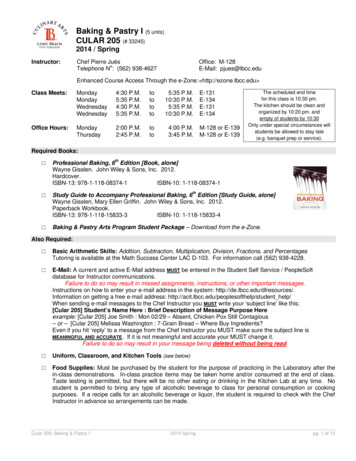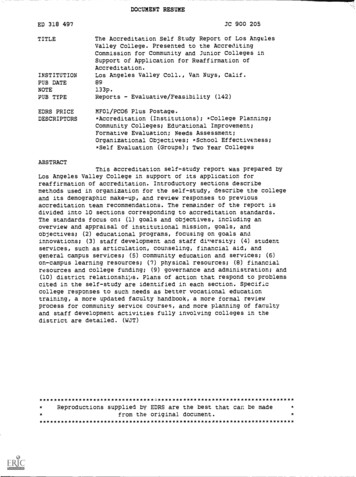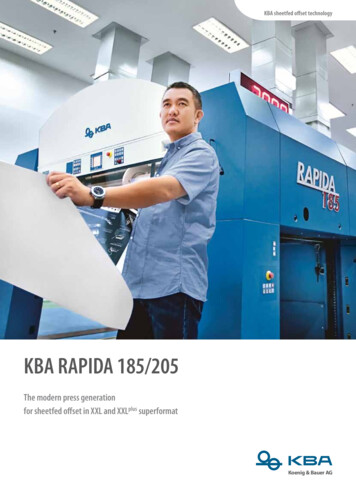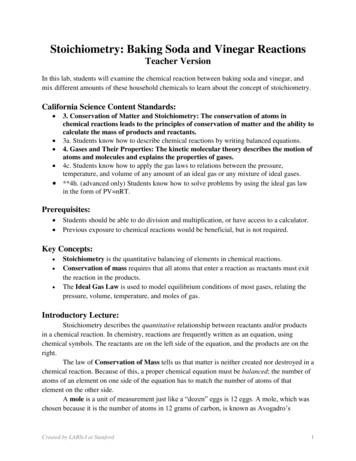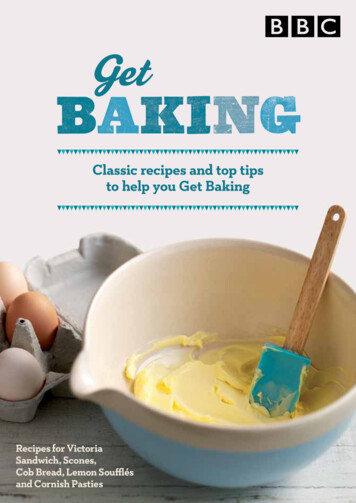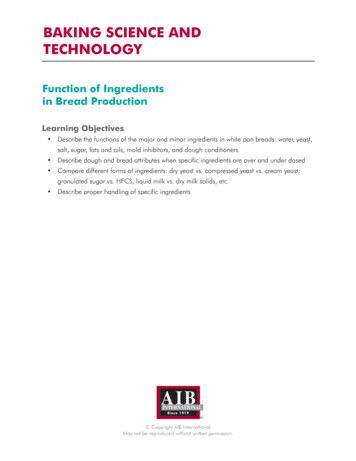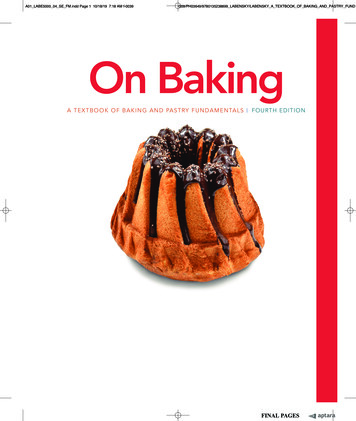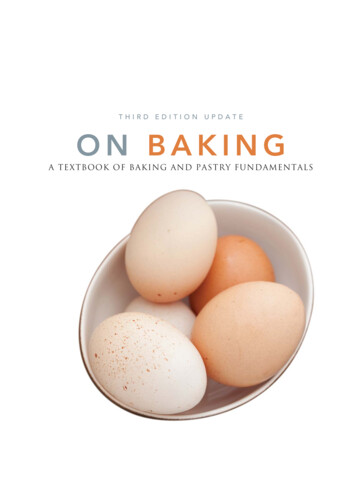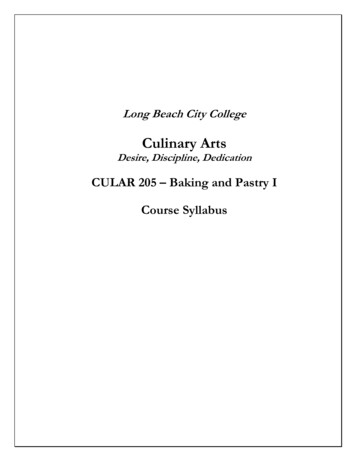
Transcription
Long Beach City CollegeCulinary ArtsDesire, Discipline, DedicationCULAR 205 – Baking and Pastry ICourse Syllabus
Long Beach City CollegeCulinary Arts DepartmentCULAR 205 - Baking and Pastry IFall 2007Class Meets:MondayMondayWednesdayWednesday4:30 p.m. to 5:30 p.m. in Room E131 LAC5:30 p.m. to 10:00 p.m. in Room E 134 LAC4:30 p.m. to 5:30 p.m. in Room E131 LAC5:30 p.m. to 10:00 p.m. in Room E134 LACInstructor:Chef Pierre JuèsTelephone No. (562) 938-4627Office Hours:MondayTuesdayThursdayRequired Books:Professional Baking, 5th Edition - Wayne Gisslen. John Wiley & Sons, Inc.College Version Hardcover. ISBN: 978-0-471-78348-0Office: H 205E-Mail: pjues@lbcc.edu2:00 P.M. to 4:00 P.M.2:00 P.M. to 4:00 P.M12:30 P.M. to 1:30 P.M.Professional Baking, 5th Edition - Wayne Gisslen. John Wiley & Sons, Inc.College Version Paperback. ISBN: 978-0-471-78350-3Student Package - Available at LBCC Viking BookstoreAlso Required:Skills: Basic Arithmetic – Tutoring is available in the library.E-Mail: A current and active E-Mail address MUST be entered in the StudentSelf Service / PeopleSoft database for Instructor communications.Uniform and Kitchen Tools: (see list on page 2)Food Supplies: Must be purchased by the student for the purpose of practicingafter the in-class demonstrations.Grading:Completion of Laboratory ProjectsAttendance & Class ParticipationProfessional Hygiene & Dress CodeClass Assignments & Research PapersQuizzes & Chapter TestsMidterm, Final Exam & Competencies30 %15 %10 %10 %15 %20 %Please Note: Final Exam must be taken on assigned date to receive a grade.Grading Scale:A90-100%B80-89 %A certificate will only be issued to students whoC70-79 %maintain a minimum of a “C” average or above, andD60-69 %complete all assignments.F59-belowIf you have any questions or need assistance with assignments, please ask your instructor.Attendance: Five unexcused late arrivals or early departures per semester will result in a grade reduction. Absences in excess of 20% of the total class hours (5 absences) is grounds for being dropped. All students MUST sign in and sign out on the daily attendance sheet. No student may sign in or sign out for another student.CULAR 205Page 1
Uniform and Kitchen Tool RequirementsUniform Requirements:Kitchen Tool Requirements:Quantity1ItemCloth Cook’s Hat1White Neckerchief2White Cook’s Jacket – Long Sleeve2Checker Slacks – Traditional Cut2White Full Aprons with Ties2White Towels10Band Aids5Pairs of Plastic Surgical GlovesQuantity1ItemChef’s Knife1Paring Knife1Serrated Edge Knife1Vegetable Peeler16" to 8" Offset Pastry Spatula118" Pastry Bag2Tips (see Chef for more information)11½" Pastry Brush1Bench Scraper1Rubber Scraper1Apple Corer1Pair of ScissorsDon’t Forget to Purchase:“““““Scantron #815 & #882 for testsNotebookPencils/PenPermanent MarkersCalculatorStudents must bring their tools to each and every class meeting, unless instructed otherwise.Code of Ethics:Deal honestly and truthfully in all matters. Respect the property and resources of others, and do notuse such property or resources for personal gain.Consider the interest of the college and carry out their established policies. Avoid activities thatmight bring discredit to oneself, the college, colleagues, or the profession. There will be noconsuming of alcoholic beverages either on the campus or at off-site culinary events.CULAR 205Page 2
Course OutlineDuring the course of the class there will be lectures and videos on the following topics: BakingEquipment; Ovens and Tools; Raw Materials and Semi-Finished Products; The Baking Process;Modern and Traditional Techniques; Baked Goods; Cookies; and Savories.At the beginning and often throughout the Lab sessions, there will be demonstrations to illustrate thedifferent procedures and techniques applied to create the different items will be studying.Watching and listening quietly to the demonstration is mandatory,any students failing to do so will be sent home.Students will develop the Basic Skills of Commercial Baking, including Preparation of Specialty andArtisan Breads, Breakfast Pastries, Baked Goods, Cookies, and Savories such as Pizzas, Pissaladière,and Vol au Vent; develop a knowledge of Supplies, Hygiene and Sanitation, Safety Practices, andEmployer-Employee Relations.Students may participate in field trips, and guest speakers may visit the program. Studentparticipation in breakfast, lunch, and dinner events are a course requirement; these may occur duringa weekend at an on-site or off-site facility.Students will be asked to do comparison-shopping, pricing, and quality research in different grocerystores, food chains, and other markets.In-class practice items may be taken home and/or consumed at the end of class.At the end of the lab session, Clean-Up is required of all students.Chef of the DayWhile in the laboratory, one student will be Chef of the Day.The Chef of the Day is responsible for making sure that:“““““Every Student Signs In and Signs OutAll Tables are CleanAll Shelves Under the Tables are CleanAll Sinks are Clean and EmptyAll LBCC Equipment is Clean, Dry and Put Away in its Proper Storage Place:o Frying Pans on the Bottom Shelfo Potso Sheet Panso Containerso Trayso Kitchen Aid Mixers and their Attachments (checked in according to the list)Food Allergies and Food IntoleranceLong Beach City College Culinary Arts Departments recognizes that a relatively small number ofstudents suffer severe allergic reactions and intolerance to one or more commonly eaten foods.The Culinary Arts Department uses foods most commonly associated with allergic reactions such as:peanuts, nuts in general, sesame seeds, fish and shellfish, wheat, soy(a), milk, and eggs.Students with known Food Allergies must notify their Chef Instructor of their specific Food Allergy.CULAR 205Page 3
Personal Hygiene/Uniform CodeA personal hygiene code is in effect in institutional kitchens with the following requirements:Jewelry:In order to provide a safe and sanitary learning experience, the ServSafe Personal Hygiene Code isstrictly enforced. Please refer to pages 4-8 of the National Restaurant Association’s EducationFoundation ServSafe Coursebook (2nd Edition).All jewelry (except a plain wedding band) including necklaces, rings, watches, bracelets, andbody jewelry (for example: nose rings, facial piercings, body piercings, etc.) are not to be wornon campus or at worksites while in uniform.The ServSafe Personal Hygiene Code (reference pages 4-8) states:“Remove jewelry prior to preparing or serving food or while around food preparation areas.Jewelry can harbor microorganisms, often tempts foodhandlers to touch it, and may pose asafety hazard around equipment. Remove rings (except for a plain band), bracelets (includingmedical information jewelry), watches, earrings, necklaces, and facial jewelry (such as noserings, etc.).”Long Beach City College is not responsible for lost or stolen articles, so it is suggested that youleave your jewelry at home.Uniform Code:A clean and neat appearance is a must at all times.All students are required to be dressed in complete uniforms when attending class and offsitelocations (such as field trips and worksites).Uniforms and aprons must be clean and without stains.Ball caps, scarves, and other hats are not to be worn while in uniform.All students must wear their uniforms with proper identification (for example: LBCC CulinaryArts button or the stitched emblem) on campus and at off-site locations.Hair:Hair must be neatly maintained, cleaned, and properly restrained at all times.All hair must be worn above your collar (hairnets).Ponytails should not be visible and must be restrained.If you wear a mustache, it must be kept neatly trimmed and must not extend below the corners ofyour lips.Beard snoods must be worn over beards.The rest of your face must be clean-shaven daily.Fingernails:Fingernails must be clean at all times, and should be of a moderate length with no fingernailpolish.Shoes:Shoes should be slip-resistant (non-skid), spill-resistant, flat, black sturdy work shoes, made ofnon-porous manmade materials or leather. Steel-toed shoes are recommended. Any other shoessuch as, high heels, open-toed shoes, and sneakers are not permitted.TB Skin Test (PPD):CULAR 205Page 4
It is required that every student participating in Culinary Arts submit a current Tuberculin Skin TestReading within the third week of the semester. The test costs 10, and an appointment must be madewith the school nurse. LAC Nurse’s Office: 562-938-4210.CULAR 205Page 5
Other Considerations:Remember that a clean and neat appearance is a must at all times.You may only use the breast pocket of the chef’s jacket for one clip-on pen or pencil and oneclip-on thermometer.In the interest of sanitation, you are not to wear aprons and side towels in the following situations:when you go to the restroom, discard garbage, enter or leave the academic building, and whileeating meals.Pagers and phones must be set to a silent ring or completely turned off during class hours.On the last day of class, students must remove their locks and personal property from lockers.(Campus Security will cut the locks and store all personal items in storage if lockers are notvacated.)Textbook AssignmentsStudents will be responsible for reading the following chapters in the textbook and completing thecorresponding chapters in the student study guide.12. Basic Syrup, Creams and Sauces14. Pastry Basics15. Tarts and Special Pastries16. Cake Mixing and Baking17. Assembling and Decorating Cakes20. Custards, Puddings, Mousses27. Baking for Special DietCULAR 205Page 6
CULAR 205: Baking and Pastry IWeekly Course OutlineFall 2009 — Mondays & WednesdaysDateWeek 108/17/09 & 08/19/09Week 208/24/09 & 08/26/09Week 308/31/09& 09/02/09Week 4 09/10/07& 09/09/09Week 509/14/09 & 09/16/09Week 609/21/09 & 09/23/09Week 709/28/09 & 09/30/09Week 810/05/09 & 10/07/09Week 910/12/09 & 10/14/09Week 1010/19/09 & 10/21/09Week 11 10/26/09& 10/28/09Week 1211/03/09 & 11/05/09Week 1311/10/09 & 11/12/09Week 1411/17/09 & 11/19/09Week 15 11/24/09 &11/26/09Week 1612/01/09 & 12/03/09Week 1712/08/09 & 12/10/09Week 1812/15/09 & 12/17/09Topic Course Introduction Safety and Sanitation Quiz Tarte Tatin Puff Pastry Dough or Pie Dough Lemon Meringue Tart Pâte Sable Pâte Brisée Orange Brûlée tart Chocolate Tart Flourless Chocolate Cake Labor Day No Classes Angel food Cake & Frosting Chocolate Sponge/Chocolate Mousse Cake Génoise / Strawberry Cream Cake & Croquants NY Chessecake Chiffon Chessecake Carrot Cake 399 Tiramisu Opéra cake Butter Cream Midterm Midterm Competency Pâte à Choux: Swans, Éclair, Cream Puff French Pastries, Petit Fours Buffet display & Presentation Chocolate Candies, Truffles, Chocolate box Flex Day No Classes Crème Caramel, Bread Pudding Crème Brûlée & Crêpe Meringue: Princess and Concorde Cakes Petit Fours Sec & Tea Cookies Guten Free brownies Low fat chocolate pie Pumpkin Pie Thanksgiving Desserts Thanksgiving Yule Log Ginger Bread House Final WeekReading & HomeworkTextbook Chapter: 15Workbook Chapter: 15Textbook Chapter: 12Workbook Chapter: 12Textbook Chapter: 16Workbook Chapter: 16Textbook Chapter: 14Workbook Chapter: 14Textbook Chapter: 17Workbook Chapter: 17Textbook Chapter: 20Workbook Chapter: 20Textbook Chapter: 27Workbook Chapter: 27Have a Great Winter Break and Happy Holidays!CULAR 205Page 7
Long Beach City CollegeCulinary Arts DepartmentCULAR 205 –Baking and Pastry ICourse SyllabusPlease complete this form and return to instructor.Semester Term:Date:Please print first and last name.I,,have downloaded the CULAR 205 – Baking and Pastry I Syllabus from the LBCC website, and Iunderstand that the instructor explained the entire syllabus to me. I am aware of: The importance of complying with the uniform code as specified in the syllabus;The books and tools required for the class;My responsibility to clean-up after myself and to actively participate in making the lab clean and orderly;My responsibilities when I am Chef of the Day; andThe importance of having a current and active E-Mail address in the Student Self Service / PeopleSoft database.I accept and will abide by the course requirements.Student Signature:Witness Name:Witness Signature:Kitchen Safety and SanitationPreventing Food Contamination and Accidents in the WorkplaceSemester Term:Date:Please print first and last name.,I,have received instruction (demonstration & written test) on Kitchen Safety and Sanitation from myinstructor. I understand this test is mandatory and I must pass with 100% accuracy. I also understandthat I may not participate in any kitchen activities until I pass. In the event that I fail, I must retakethis test until this requirement is satisfactorily completed.Student Signature:Witness Name:Witness Signature:CULAR 205Page 8
Long Beach City CollegeCulinary Arts DepartmentKitchen Safety and SanitationPreventing Food Contamination and Accidents in the WorkplaceIt is vitally important to introduce student culinarians to the principles of kitchen safety,sanitation, and proper food storage techniques prior to actual work in a kitchen laboratoryenvironment. In order to project a proper professional image throughout this program, it is essentialthat students arrive to class daily, in full uniform (suited and booted), well groomed, and inpossession of all materials necessary for the days activities (books, tools & equipment, etc.).It is the responsibility of the Chef Instructor to identify and demonstrate the safe and properuse of all potentially dangerous equipment in the kitchen. Following this instruction, each studentmust take and pass a practical and written test, scoring no less than 100% prior to proceeding withhis/her lab duties.Prior to beginning any culinary project, the Chef Instructor and students will conduct athorough walk-through of all kitchen areas and walk-in refrigerators. Any observation of kitchensafety or sanitation violations should be outlined and reported to the Chef. At the end of the day, afinal walk-through will be conducted by the student chefs, and Chef Instructor. These walk-throughprocedures are to be conducted at school, work experience locations, and off-site locations (QueenMary Hotel etc.).It is the responsibility of all Chef Instructors to maintain the Kitchen Log Book located in thekitchen office. On a weekly basis, a thorough check and cursory inventory will be done by each ChefInstructor on a rotating basis, noting any violations or potential hazards. If none are observed, thattoo will be noted and signed by the inspecting Chef. The Kitchen Log Book will be reviewed weeklyat the staff meeting.It is extremely important that every student store and transport all sharp tools and equipmentin a professional tool bag. Students are not to store or transport knives and other culinary equipmentwrapped in towels, plastic wrap, paper, backpacks, boxes, or any other material that could pose ahazard to any individual or themselves.As a rule, culinary students are required to review and test each semester, Chapter 4 “Foodand Kitchen Safety” in their textbook The Professional Chef.Accidents, illnesses, or injuries sustained in the lab areas, classrooms, or offsite locationsmust be reported to the Chef Instructor immediately. For minor cuts, a student should wash the cutthoroughly and apply a band aid; the instructor will complete an Accident Report. In the event of asevere cut or injury, the student must be sent to the Health Services nurse during regular schoolhours. If the injury requires emergency medical attention, you may either use your primary insurancefirst or student medical insurance at Long Beach Memorial Hospital Emergency Room ( 50.00deductible payable by the student). Following this procedure the student must return the followingday to the Long Beach City College Health Services nurse in order to complete an Accident Report.The following are some recommendations to prevent food contamination and accidents in theworkplace:Personal Hygieneo Do not work with food if you have any communicable disease, cuts, or infection.o Bathe or shower daily.o Wear clean and pressed uniforms and aprons.o Keep hair neat and clean, always wear a hat or hair net.o Keep mustaches and beards trimmed and clean - better yet, be clean shaven.o Students are not to eat while in the lab, only tasting approved by the Chef Instructor.CULAR 205Page 9
o Wash hands and exposed parts of arms before work, and as often as necessary during work,including: After eating, drinking, smoking, or discarding rubbish. After using the toilet. After touching or handling anything that may be contaminated with bacteria.o Cover coughs and sneezes, and then wash hands.o Keep your hands away from your face, eyes, hair, and arms.o Keep fingernails clean and short. Do not wear nail polish.o Do not smoke or chew gum while on duty.o Cover cuts or sores with clean bandages. Wear a glove over the bandage.o Do not sit on worktables.o Do not wear ear or facial piercings; only a watch and wedding band are allowed.o Uniform pants are to be pressed and properly hemmed, without exception, for both professionalappearance, and health and safety requirements.o Wallet chains, clasps or any other metal or leather belt accessories are not to be worn as part ofthe student’s uniform.The Safe WorkplaceIt is important to find ways students can prevent certain kinds of accidents (i.e. cuts, burns,and falls). However, it is much easier to develop and practice habits that prevent accidents if safety isbuilt into the workplace.Adequate lighting in work areas and in corridors.Non-slip floors.Clean as you go to keep slip hazards off the floor.Clearly marked exits.Equipment supplied with necessary safety devices.Heat-activated fire extinguishers over cooking equipment, especially deep fryers.Conveniently located emergency equipment, such as fire extinguishers, fire blanket, and first aidkit.o Clearly posted emergency telephone numbers.o Smooth traffic patterns to avoid collisions between workers.o Equipment that is clean and in proper working order (free of missing or loose parts).oooooooCleaning and SanitizingThe key to cleaning and sanitizing is that it is impossible to sanitize a dirty surface. The onlyway is to clean a surface and then sanitize it – two independent steps that cannot be accomplished in atwo-in-one type of application or process.o Cleaning and Sanitizing is a two-step process.o Cleaning removes soil or food particles from the surface.o Sanitizing involves using moist heat or chemical agents to reduce the number of microorganismson the surface.o Cleaning is very different from sanitizing.o Clean equipment such as knives and cutting boards during food preparation – use a wiping cloth,soaked in a double-strength sanitizing solution.o Small equipment (tools, pots and tableware) should be run through a ware-washing machine orwashed manually in a three-compartment sink.o After sanitizing, equipment and tableware should be allowed to air-dry completely, because usingpaper or cloth toweling could result in cross contamination.CULAR 205Page 10
Cross-Contamination EliminationCross-contamination occurs when microorganisms are transferred from one contaminatedsurface to another surface. Many food-borne illnesses are a result of unsanitary handling proceduresin the kitchen. According to the National Restaurant Association’s Education Foundation ServSafeCourse book (2nd Edition), cross-contamination results when:Contaminated ingredients are added to food that is not later cooked.Contaminated food is allowed to touch or drip fluid onto cooked or ready to eat food.A food handler touches contaminated food and then touches cooked or ready-to-eat food.Cooked or ready-to-eat food touches a contaminated surface.Contaminated cleaning cloths are not cleaned and sanitized before use on another food-contactsurface.o Prevent cross-contamination by not handling ready-to-eat
The Culinary Arts Department uses foods most commonly associated with allergic reactions such as: peanuts, nuts in general, sesame seeds, fish and shellfish, wheat, soy(a), milk, and eggs. Students with known Food Allergies must not
